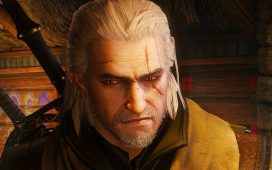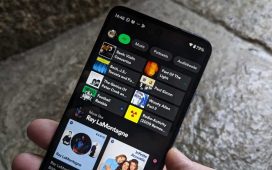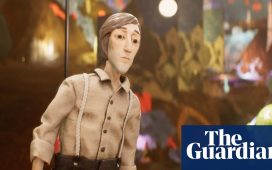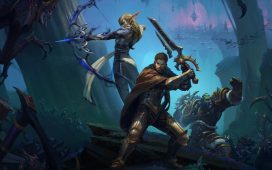Consider it for a second: cadence. What a perfect Zelda-ish word. Cadence! This word is a song and a river and a waterfall. It is cascading and it is radiance. It says there is a hidden order in nature and this order is beautiful – elegant and taut and melancholic and not to be messed with. Zelda is filled with wonderful words of its own devising. It has Hyrule, it has the Triforce. Here is a word of our own that fits perfectly. It has the right… it has the right cadence.
So much about Cadence of Hyrule feels like this: a meeting of distant worlds that results in something that just snaps together as if it was meant to be, that results in something harmonious. The pitch is gloriously weird: Crypt of the NecroDancer, a rhythm-action procedural dungeon-crawl is to be stirred together with Zelda, perhaps the least procedural game series of all time. In Zelda, nothing is ever left to chance, every outcome, every possible action has been foreseen. It’s almost a problem. The series’ defining moment, for me anyway, is that bit in Wind-Waker where Link travels beneath the surface of the Great Sea and finds Hyrule itself frozen in a bubble. Even after a deluge, even after the apocalypse, everything is in its place.
And yet it works. But it takes a bit of getting used to.
Here’s the idea. Cadence of Hyrule takes the world of Zelda and the combat of NecroDancer and makes them work together. You explore Hyrule as Link – or Zelda or Cadence, zapped in from a distant world, each character having their own special abilities and available in co-op – and it’s filled with recognisable landmarks like Lake Hylia and those muddlesome woods. But each screen of Hyrule is its own little combat encounter: a chunk of carefully designed terrain filled with baddies and treasure chests and – perhaps! – hidden areas and opportunities.
And you move to a beat here, yomping from one spot to the next in time with the lavishly reworked Zelda tunes, given an electro buzz one second and a disco bounce the next. Combat is automatic – you bump into enemies as if you’re clumsy on the dancefloor. In fact, as you move there’s often a dancefloor effect underneath you. Battling is all to do with timing and placement: you need to learn the rhythm of an enemy and then insinuate yourself into that rhythm, ducking around strikes, avoiding shields and getting the smack on your foes when they’re wide open.
It’s hard to get your head around at first. The weapons you find and equip have their own attack ranges and damage quirks – a flail I found had a really wide area but also hopped me forward, a poisoned dagger inflicted damage over time – and then there’s the fact that it’s all sort of built around that roguelike staccato rhythm. The beats of the song control the pace of your enemies, when they move, when they strike, when they leave themselves unguarded. Each enemy, then, is both a song to learn – this is particularly true of bosses – and a puzzle to solve. The fun of it is that the game throws so many enemies at you at once so you’re basically turning this way and that, being all things to all people, the master of all rhythms, a quick-change artist who never puts a foot wrong. It’s thrilling!
Defeat all enemies on the screen and you get a diamond you can spend at the post-death upgrade shop. And here’s where things get even weirder. Cadence has weapons to find and familiar gadgets to track down – the hookshot, the boomerang, a glove that allows you to lift heavy stuff, bombs et al – but it also has weapon durability, and loot that you can equip like rings and armour but which you lose when you die. You might have a great ring that allows you to deflect the first blow. Enjoy it mate. Enjoy it while you can, because when you die, you’ll keep your flail and your boomerang but that ring is gone. Ditto perk-giving armour. Ditto your torch that lights the way – some of them have perks and whatnot of their own – and your shovel that allows you to carve through earth and find hidden stuff. It can be tricky at first to understand what you keep and what you lose, but the idea should be familiar to anyone who’s played a few roguelikes. Each run is different, and it’s different because the world scrambles, sure, but also because you are different as a result of the items you found on that run.
It adds a wonderful jolt of unpredictability to the Zelda template, as does the fact that the map of Hyrule, I gather, can be different for every player, those carefully-designed tiles of real estate going back into the Scrabble bag and coming out a little differently. And there are opportunities too. Whenever you die you end up in that void-shop that allows you to spend your diamonds on a randomly selected range of goods that can help shape the next run. Zelda benefits from this jolt of fortune, good or bad.
But it is still Zelda. Your quest ultimately leads you all across the overworld and through a range of dungeons, back to Hyrule castle and a series of final boss fights. Familiar sights abound and the art does a wonderful job of sitting somewhere between the Minish Cap and Link to the Past. In terms of scale, this is a compact Zelda game – the previous title it reminds me the most of in this regard is Link’s Awakening, never a bad thing. But it makes up for its smallish footprint with its sheer delight in discovery as you wander about, everything half familiar, every ultimately a surprise.
And along the way, a fundamental retilting of things has taken place. There are puzzles in Cadence, but this is a combat game at heart. Dungeons, for example, still have maps and compasses and boss keys, but they’re focused pretty strongly on chucking you into massive brawls, clearing out rooms and finding keys in order to progress. If anything, the standout puzzles really are the bosses themselves. You can launch right in there and try to smack them around, but these are ultimately sets of behaviours to unravel and rhythms to turn to your own advantage. One of them was really terrorising me until I realised I could actually stand still and finish it off almost without moving. Victory against another – this is so weird to type – pretty much relied on learning how the boss behaved during its theme song’s middle eight. What an odd Zelda this is!
What an odd Zelda, but what an absolute delight. There is a theory that has stood up until now that runs that Zelda in the hands of anyone other than Nintendo is, at best, a little pale. Minish Cap was lovely, but it was no Link to the Past. The Oracle games were great, but Zelda should never be just great.
Yet Cadence is better than great. It’s an authentic banger, frankly – a Zelda game to be savoured. It’s surprising and strange and funny and sad and thrilling. And when it’s over, the game that lives on in your memory really feels like Zelda.














